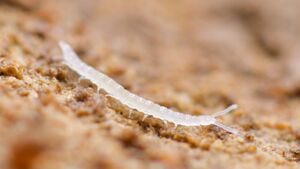Symphyla: Difference between revisions
No edit summary |
No edit summary |
||
| Line 28: | Line 28: | ||
The quick moving symphyla primarily feed on decaying plant material and fungi, and are considered [[detritivores]], eating and helping to break down [[Organic Matter]] [1]. Some species can be herbivores and are considered pests to certain crops, such as ''Scutigerella immaculata'' or the garden centipede [1]. When available, they will feed on the seedlings or root fibers of these crops, causing damage [5]. Few species can be predatory [1]. | The quick moving symphyla primarily feed on decaying plant material and fungi, and are considered [[detritivores]], eating and helping to break down [[Organic Matter]] [1]. Some species can be herbivores and are considered pests to certain crops, such as ''Scutigerella immaculata'' or the garden centipede [1]. When available, they will feed on the seedlings or root fibers of these crops, causing damage [5]. Few species can be predatory [1]. | ||
== | == References == | ||
Revision as of 20:13, 10 May 2022
Taxonomy
| Kingdom | Phylum | Subphylum | Class | |
|---|---|---|---|---|
| Classification | Animalia | Arthropoda | Myriapoda | Symphyla |


Description
Symphylans are small pseudocentipedes in the phylum Arthropoda and the subphylum Myriapoda. Though they resemble centipedes, they are much smaller ranging in size from 2 to 30 millimeters depending on location, and are translucent in color [1]. Colored symphyla only occur when they absorb color from food, usually yellow or red [2]. Symphyla have two body regions, a head and a segmented trunk, containing a range of segments from 15-24 with 12 pair of legs throughout on the trunk which allow them to move rapidly throughout the soil, and segmented antennae on the head [1]. Each leg has a stiff spine at the base, promoting movement, and a small sac, which allows for fluid exchange and regulation in the creature [2]. Younger symphylans only have 6 pairs of legs, but these increase to 12 throughout their lifetimes [1]. Symphylans also have a postantennal organ on their head region, similar to collembola, and 3 mouth parts [1]. There are two families of symphylans, being the Scutigerellidae and the Scolopendrellidae, which can only be easily differentiated by the rounded head of the Scutigerellidae opposed to the flatter of the Scolopendrellidae [2], and form a combined species total of around 200 [1]. Both families lack eyes and are blind, so their antennae serve as a sensory tool [1].
Life Cycle and Habitat
Symphylan eggs can be found in any season, but typically the most eggs are found in the fall and early spring when weather is cooler [3]. Increasing egg numbers can also be found in April to August in the upper layers of the soil [4]. Eggs are white with ridges when first laid, and turn a light tan color throughout their cycle [4], and can be produced in groups anywhere between 4 and 25. These eggs typically hatch in about 40 days [3], producing young symphylans or nymphs. This means that nymphs and adults are active in late fall to winter and the spring [4]. Nymphs have less trunk segments compared to adults, and only have 6 pairs of legs as opposed to 12. While life cycle and span depend on different conditions, such as soil temperatures, soil moistures, and soil structure, it typically takes around 4 months for a nymph to progress into an adult in moderate conditions, meaning the full egg to adult process takes about 5 months [4]. These arthropods can be found worldwide but are predominant in the tropics, and are located in the northeast, north central, and western United States [3]. Since they cannot burrow holes into soil themselves, they rely on gaps created by plant roots, and larger creatures such as the earthworm, much like the other soil mesofauna [2]. There are usually one to two generations per year [3], and their full life cycle is typically 6 to 12 months, shedding their casings several times [2].
Feeding
The quick moving symphyla primarily feed on decaying plant material and fungi, and are considered detritivores, eating and helping to break down Organic Matter [1]. Some species can be herbivores and are considered pests to certain crops, such as Scutigerella immaculata or the garden centipede [1]. When available, they will feed on the seedlings or root fibers of these crops, causing damage [5]. Few species can be predatory [1].